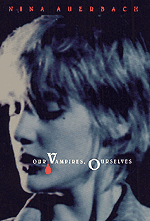The Young and the Bloodless

Got blood? Anyone that has been anywhere near a bookstore, a multiplex, or a television lately knows that vampires—those undead creatures of the night—are hot, even though their skin might be cold. Between Stephenie Meyer’s blockbuster Twilight novels (and their big-screen incarnations—the second film in the franchise, New Moon, has earned nearly $500 million worldwide in an astonishing 12 days) and HBO’s original series True Blood (based on Charlaine Harris’s novels), dead is the new black. But how do these modern vampires stack up against the classics? We asked Nina Auerbach, author of Our Vampires, Ourselves (which argues that every age embraces the vampire it needs, and gets the vampire it deserves), why Edward Cullen and Bill Compton are so popular. Read her fascinating response below:
When I was young, vampires were old; they were gorged with history as well as blood. Now, they’ve turned young and innocent, while I’ve become, er, ripe, if not quite old. When I was a teen-ager—and even later, when I wrote Our Vampires, Ourselves—I loved Dracula for his evil powers, but now teenagers seem to love Undead Edward, the prudish hero of the long Twilight series, for his virtuous inhibitions. Smoldering through high school like a homogenized James Dean, Edward spends his time with his palpitating mortal girlfriend Bella trying not to touch her; his glamour is not his vampirism, but his suppression of vampirism. Who would have thought a creature of the night could be so rabid a believer in daylight virtues like celibacy and family values?
When Edward is not restraining himself, he is rescuing Bella from improbable perils. More clean-cut Superman than smelly Dracula, he is uncannily swift and strong, but though he talks about his hunger, we never see him eat—or drink. Like other vampires of his generation, Edward is a self-immolating adolescent. Time, loss, war, and history can’t touch him. Vampires used to contain worlds; now they immunize themselves against the dark times that bred them.
The HBO series True Blood is almost as popular as Twilight, though since it enjoys the license of cable television, it wallows in sex and violence—among bad vampires that is; the good ones swim in ontological self-doubt. The series imagines a benignly integrated future in which vampires mingle with mortals because they are no longer predators: instead of human blood, they drink a synthetic compound called True Blood. Those who revert are either stricken with guilt or part of a faceless snarling horde.
Like Twilight, True Blood has its genesis in a seemingly interminable series of long episodic novels by Stephenie Meyers and Charlaine Harris respectively: since they have no visible endings, these winding works are not constructed around the vampire’s death or, at least, banishment; like the shapelessness of youth, they threaten to meander along forever. Like Twilight, True Blood features vampires who are adolescents in their souls. Bill and Eric, rivals for the love of pretty mortal Sookie, are old in years but awash in romantic nostalgia. Bill, a Confederate soldier who was vampirized during the Civil War, has lived through rending social changes, national trauma and tragedy, but like a boy, he sees only the domestic haven his death and Undeath obliterated. Eric is supposed to be older and more powerful than Bill, but he is most vivid as a perpetual son, weeping over the true death of his vampire mentor. In both Twilight and True Blood, the vampires are so bland and so lost that we need other, more grotesque creatures to galvanize us into fear. Werewolves, shape shifters, maenads, the now-ubiquitous zombies, and strange, nameless monsters abound to compensate for vampires who have lost their bite, their history, and their blood.
Self-mortifying adolescents are dull, but child-vampires are truly frightening because they are their appetites. The Swedish art film Let the Right One In (2008), the most frightening recent vampire movie I’ve seen, deals with children. Alienated, brutalized little Oskar finds a girlfriend, Eli, who is an unabashed vampire. Like Edward, Eli is a rescuer, but a savage one: unlike her male counterparts in American films, Eli has no compunctions about killing and chomping or, in a climactic triumph of love, dismembering the boys who bully Oskar. Far from protecting Oscar against her bloodthirst, she tries to instill her savagery in the timid boy. Eli is as sexy and savage as a vampire should be, but she is of her time in that she knows no time. When Oskar asks her, “Are you old?”, she answers coolly, “I’m twelve. But I’ve been twelve for a long time.”
What was Eli before she was twelve? What will she be in twelve thousand years? Eli has many traditional attributes—not only bloodthirst, but ferocious loyalty with a scent of melancholy. Unlike her progenitors, though, she has neither memory nor vision. Dracula replayed his ancient battles against the Turks and dreamed of his imperial future. Even a much later vampire, Mae, a young girl like Eli who presides over Kathryn Bigelow’s wonderful movie Near Dark (1987), celebrates her limitless future in celestial terms: “I’ll still be here when the light from that star gets down here to Earth in a billion years.”
Vampires today have no such glorifying imaginations. Repetitive and one-dimensional, they lack the layers of lives that composed the vampires I loved. Eli, Edward and the rest have no affinity with starry transports; in their dreams, if they dream, they will be doing the same things in the same settings thousands of years from now. And as always, our vampires are ourselves. In a generation where blood is tainted, history has shrunk to a search engine, and the future is a shrinking planet, flattened vampires are the vampires who belong.